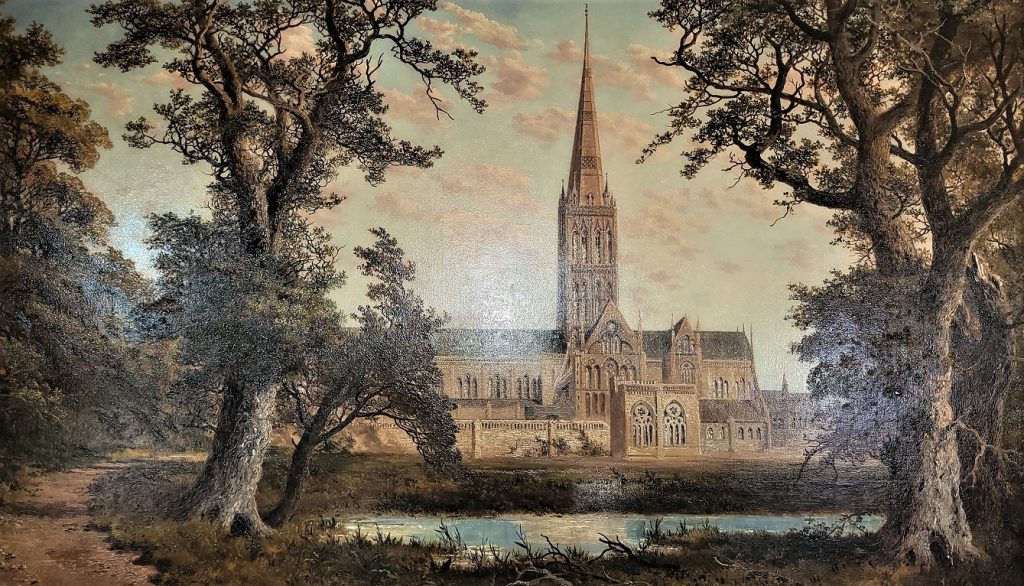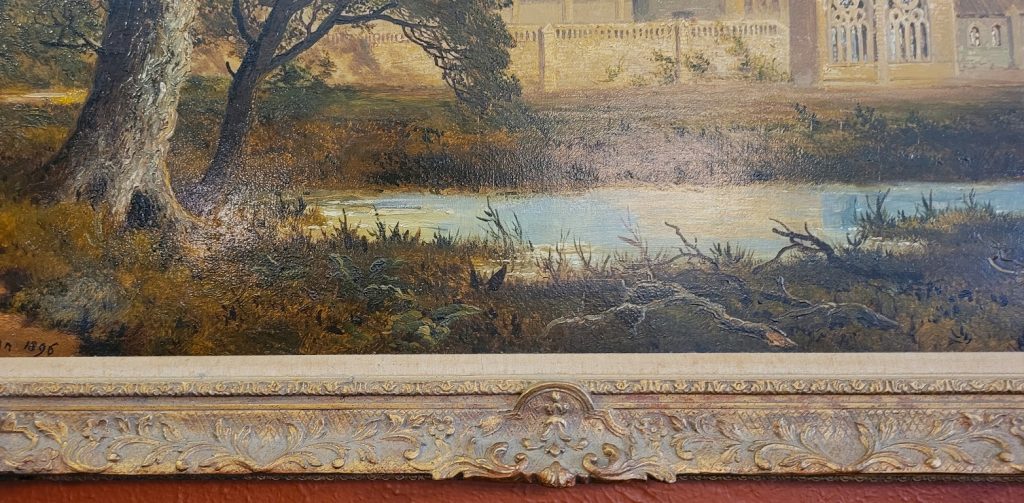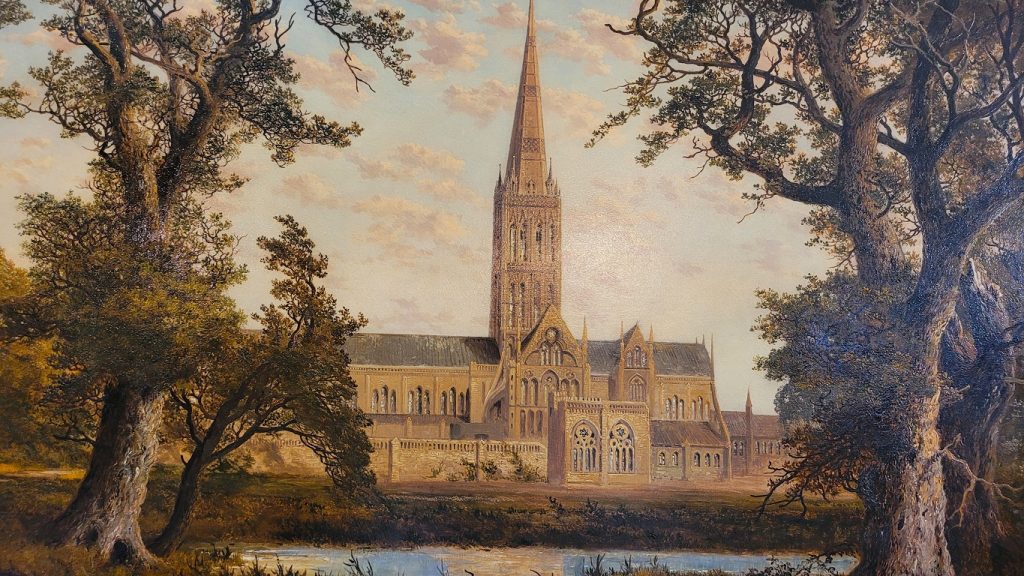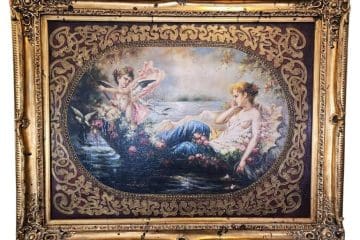‘Salisbury Cathedral’ Oil on Canvas by Edmund John Neimann 1876
PRESENTING A STUNNING, IMPORTANT AND HIGHLY DESIRABLE 19th Century English Landscape painting of ‘Salisbury Cathedral’, Oil on Canvas by Edmund John Neimann 1876.
Large painting of a very desirable landscape image of the world famous, ‘Salisbury Cathedral’ by the famous English landscape artist, Edmund John Neimann (1813-1876).
This oil on canvas is simply BEAUTIFULLY PAINTED!
The quality of the detail to the Cathedral building, River Avon, sky, puffy pink clouds and trees, is simply OUTSTANDING and most definitely by the ‘hand’ of ‘Neimann’.
Signed on bottom left as “Neimann 1876”.
COA on the back.
In original gilt frame with original matting.
All the genuine signs of age and authenticity.
The signature is correct and has been compared and is identical to fully authenticated Niemann signatures (see below).
The signature has been examined under ‘black light’ and is not a later addition. It is original to the painting.
It has been cleaned and has no tears or noticeable losses, it is is great original condition.
Colors are still very vibrant.
We are confident, that this was one of the last paintings made by Neimann before his death in 1876.
We acknowledge that the date on the painting most definitely looks like ‘1896’ and this concerned us greatly, as this would have been 20 years after the artist’s death.
The ‘COA’ on the back of the frame also concerned us somewhat, due to: (1) the artist originally being identified as ‘Ernest Neimann’ (no records of any such artist) and it was changed by pen, to “EJ Neimann”. Also, (2) it gives the date as ‘1896’, which is simply not possible for Edmund John Neimann who died in 1876.
These ‘concerns’ led us to a deep and thorough research of all these issues, in an attempt to answer the questions.
At first we thought, that maybe it was possible that Edmund’s son, Edward H. Neimann (active from 1863-1887) and also a talented artist, could have either painted it or finished it for his father, after his death in 1876, BUT Edward himself, died in 1887 which still predates 1896.
Then we thought that maybe, one of Neimann’s students could have finished it, BUT, 20 years after his death is highly unlikely.
The COA does not help much, as we can find no record of the company that issued it, namely, ‘F.R.’. The COA looks mid 20C to us, which is not that concerning, as it would not be unusual to have a new owner seek to authenticate. The fact that it has a Registered Number of ‘5511’ is not very helpful, if you cannot find the register!
Then, we zoomed in on/magnified, the date on our painting and noticed that the ‘9’ in ‘1896’ does not completely conjoin. Was it possible that the “9′ was, in fact, a “7”?
We looked for Neimann signatures and paintings that have previously appeared on the market, which had been fully authenticated, that were painted and dated by the artist in the 1870’s. Was it simply a ‘poorly’ drawn ‘7’ or perhaps simply the artists quirk with how he drew his ‘7’s’.
We discovered a painting that had been sold by a well-known and very reputable art auction house on the west cost of the US, in 2020, that was listed as by ‘Edmund John Neimann (1843-1910) signed and dated 1895. Not only are the dates for EJ Neimann ALL wrong, but the signature was correct and again, the date looks like it is “1895’, which is simply not possible.
We searched, to compare fully authenticated signatures of Niemann from any time in the 1870’s, and discovered a number of them, where the “7” was drawn in a loop. Whilst, somewhat ‘loopy’ they were identifiable as “7’s”, but in 1/2 cases were close enough to conjoining, to be confused with a “9”.
In conclusion, after our extensive research, we are of the firm belief and opinion, that the date on this painting, is in fact ‘1876’ and NOT ‘1896’. The “9” is in fact, a poorly drawn ‘7’.
This is therefore, a hither-to-fore unknown painting by Edmund John Neimann of the famous ‘Salisbury Cathedral and quite possibly, one of the very last paintings he ever painted, making it EXTREMELY important!
Salisbury Cathedral, formally the Cathedral Church of the Blessed Virgin Mary, is an Anglican cathedral in Salisbury, England. The cathedral is the mother church of the Diocese of Salisbury and is the seat of the Bishop of Salisbury.
The building is regarded as one of the leading examples of Early English Gothic architecture. Its main body was completed in 38 years, from 1220 to 1258.
The spire was built in 1320. It was heightened to 404 feet (123 m) and has been the tallest church spire in the United Kingdom since 1561. Visitors can take the “Tower Tour”, in which the interior of the hollow spire, with its ancient wooden scaffolding, can be viewed. The cathedral has the largest cloister and the largest cathedral close in Britain at 80 acres (32 ha). It contains a clock which is among the oldest working examples in the world, and has one of the four surviving original copies of Magna Carta. In 2008, the cathedral celebrated the 750th anniversary of its consecration.
Link: https://en.wikipedia.org/wiki/Salisbury_Cathedral
Edmund John Niemann (1813–1876) was a prolific and highly successful British landscape artist working mostly in oils. Nine of his paintings are held in the Wolverhampton Art Gallery.
Niemann was born in Islington, London in 1813. His father, John Diedrich Niemann, was a native of Minden, Westphalia and was a member of Lloyd’s, working in the City of London. As a young man, Edmund was employed as a clerk at Lloyd’s, but he decided to devote himself to art and in 1839 settled in High Wycombe, Buckinghamshire, mostly painting out of doors. Though he especially enjoyed painting the scenery of the Thames and of the River Swale, near Richmond in Yorkshire, many other areas of the British Isles are covered in the corpus of his work.
Between 1844 and 1872, he exhibited paintings at a wide range of prestigious galleries including the Royal Academy, the British Institution, the Society of British Artists in Suffolk St, the Royal Scottish Academy, the Royal Institute, the Glasgow Institute, the Paris Salon, the Liverpool Academy of Arts and the Manchester Academy of Fine Arts. The first picture exhibited was a view “On the Thames, near Great Marlow, Bucks” – a small canvas shown at the Royal Academy in 1844.
Niemann and a number of other artists, including Edward Armitage were dissatisfied with the exclusiveness showed by the management of several leading art societies. In 1848 Niemann returned to London for the foundation of the ‘Free Exhibition’ held in the Chinese Gallery at Hyde Park Corner. This exhibition opened with 500 works of art including sculpture. In 1850 this became the Portland Gallery, Regent Street, and Niemann was chosen as one of the trustees and honorary secretary. The society later assumed the name ‘The National Institution’. The existence of the society was short lived with 1861 seeing the last of their exhibitions.
Niemann lived at Mount Vernon House in Hampstead in the 1850s.
His paintings are characterised by great versatility, natural colours, and visual realism, often in the romantic artistic style of J. M. W. Turner, Corot and Caspar David Friedrich. His son, Edward H. Niemann, was also a painter imitating his father’s style.
Ill for a number of years in his later life, Niemann died suddenly at Brixton Hill, Surrey of apoplexy on 15 April 1876.
Link: https://en.wikipedia.org/wiki/Edmund_John_Niemann
The image, is a view of the Cathedral from the Bishop’s Grounds and is very similar to the famous painting by John Constable in 1823 of “Salisbury Cathedral from the Bishop’s Grounds‘ currently held by the Victoria & Albert Museum in London.
‘Salisbury Cathedral’ Oil on Canvas by Edmund John Neimann 1876
Provenance: Acquired from a local Dallas Auction.
Dimensions: In Frame: 61 inches wide, 40 inches tall and 2.5 inches deep.
Canvas: 54.5 inches x 34.5 inches
Condition: Very good original condition.
SALE PRICE NOW: $28,000


































